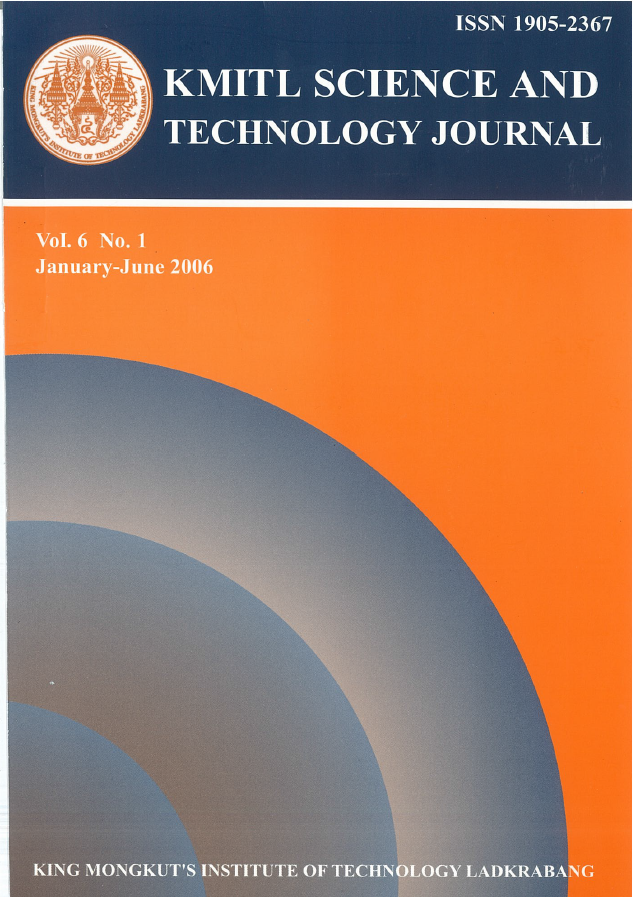Studies on Fermentation of Monascus purpureus TISTR 3090 With Bacterial Cellulose From Acetobacter xylinum TISTR 967
Main Article Content
Abstract
Bacterial cellulose produced by Acetobacter xylinum TISTR 967 was fermented by Monascus purpureus TISTR 3090 in culture medium on a rotary shaker at 150 rpm, 30 ˚C for 12 days. Sucrose concentration of 5% (50 g/l), ammonium nirate concentration of 1.5%, initial pH at 5.5 and a temperature at 30 ˚C resulted in the production of an appealing bright red color. The color stability study was carried out using a medium composed of 5% sucrose, 1.5% ammonium nitrate and initial pH 5.5 for fermentation at 30 ˚C for 12 days. Products demonstrated good resistance to washing, heat, freezing, acidification and irradiation.
Keywords: Bacterial cellulose, Fermentation, Monascus purpureus
Corresponding author: E-mail: Kodaungi@kmitl.ac.th
Article Details
Copyright Transfer Statement
The copyright of this article is transferred to Current Applied Science and Technology journal with effect if and when the article is accepted for publication. The copyright transfer covers the exclusive right to reproduce and distribute the article, including reprints, translations, photographic reproductions, electronic form (offline, online) or any other reproductions of similar nature.
The author warrants that this contribution is original and that he/she has full power to make this grant. The author signs for and accepts responsibility for releasing this material on behalf of any and all co-authors.
Here is the link for download: Copyright transfer form.pdf
References
[2] Roberfroid, M. 1993. Dietary Fiber, Inulin and Oligofructose: A Review Comparing their Physiological Effects, Crit. Rev. Food Sci. Nutr., 33, 103-148.
[3] Banzon, J.A. Gonzalez, O.N., Dedeon, S.Y. and Sanchez, O.C. 1990 Nata de coco. In: Banzon J.A., ed. Coconut as Food. Diliman, Quezon City, Philippines, Phillippine Coconut. Research and Development Foundation, pp 185-190.
[4] Cannon, R.E. and Anderson, S.M. 1991 Biogenesis of Bacterial Cellulose, Crit. Rev. Microbiol., 17(6), 435-447.
[5] Embuscado, M.E., Marks, J.S. and BeMiller, J.N. 1994 Bacterial Cellulose I. Factors Affecting the Production of Cellulose by Acetobacter xylinum, Food Hydrocolloid, 8(5), 407-418.
[6] Lin, C.F and Lizuka, H. 1982 Production of Extracellular Pigment by a Mutant of M. kaoling sp., Appl. Env. Microbiol., 43(3), 671.
[7] Kim, C.S., Sook-hee, R. and Kim, I. 1977 Studies on the Production and Characteristics of Edible Red-Color Pigment Produced by Mold (Monascus sp), Korean J. Food Sci. and Tech., 9, 277.
[8] Shepherd, D. and Carels, M.S.C. 1978 Production of a Pigment from Monascus., Swiss Patent, 606, 421.
[9] Tadao, H., Shima,T., Suzuki, T., Tsukioka, M. and Takahashi, T. 1982 Edible Yellow Pigments from Monascus, Jap. Patent, 81, 006, 263.
[10] Lin, C.F. 1973 Isolation and Cultural Conditions of Monascus species for the Production of Pigment in a Submerged Culture, J. Ferm. Tech., 51, 407.
[11] Su, Y.C., Dhen, W.L. and Lee, Y.H. 1973 Studies on the Anka-Pigment Produced by a Mutant of M. anka, Res. Rep. Coll. Agri. Nat. Taiwan Univ., 14,41.
[12] Wong, H.C. and Koehler, P.E. 1981 Mutant for Monascus-Pigment Production, J. Food Sci., 46(3), 956.
[13] Wong, H.C. and Bau, Y.S. 1977 Pigmentation and Antibacterial Activity of Fast – Neutron and X-ray Induced Strains of M. purpureus, Wert. Plant Physiol., 60, 578.
[14] Lin, CF and Demain, A. 1991 Effect of Nutrition of Monascus sp on Formation of Red Pigments, Appl. Microbiol. Biotechnol., 36, 70-75.
[15] Sheu, F., Wang, C.L and Shyu, Y.T. 2000 Fermentation of Monascus purpureus on Bacterial Cellulose-nata and the Color stability of Manascus-nata Complex, J. Food Sci., 65(2), 342-345.


